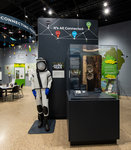

A piece of Blaine is now displayed for the world to view at the Smithsonian National Museum of Natural History in Washington, D.C.
The first Asian giant hornet nest found and eradicated in the U.S., or “nest zero,” was displayed July 1 in the Smithsonian’s new “Our Places: Connecting People and Nature” exhibition. The exhibit explores how peoples’ experiences with nature across the globe motivates them to care for and protect the environment, according to a National Museum of Natural History announcement on the exhibit’s opening.
In addition to the nest, the exhibit will include the eradication suits and hornet tracker to educate museum-goers on threats of invasive species. “Our Places” will also look at the equity of green spaces in urban settings, Indigenous practices to restore arid soil and minority-owned aquaculture programs in Chesapeake Bay.
“By emphasizing that we are all connected to the natural world, ‘Our Places’ provides new opportunities for heightening understanding of our planet’s biodiversity and a range of environmental justice issues,” said Torben Rick, the museum’s curator of North American archaeology, in the announcement.
The nest is displayed in the museum thanks to Birch Bay beekeeper Ruthie Danielsen, who purchased the nest in February 2021 from an east Blaine resident in hopes to use it for further education. Danielsen had been racing to eradicate the invasive species from Whatcom County after learning about the hornets at a Mt. Baker Beekeepers Association meeting in February 2020. Understanding that local honey bees already faced threats, Danielsen knew the last thing they needed was an apex predator that could decapitate a hive in a matter of hours.
Danielsen allowed the Washington State Department of Agriculture (WSDA), leading eradication efforts, to borrow the nest for DNA research with the promise that she would be able to show it at the Lynden fair and then display it in the Smithsonian.
“Most of the time, unless you’ve actually seen something, you don’t really understand how big or large it is,” Danielsen said. “The visual will add an awareness and understanding for folks and create a significant emotional event that will hopefully get them involved in invasive species in their area.”
With the nest in one of the world’s most famous museums, Danielsen is still continuing her work to make sure the Asian giant hornet doesn’t become established in Whatcom County. The Mt. Baker Beekeepers Association hung over 100 traps this year, Danielsen said, encouraging Whatcom County residents to start hanging traps and inspecting paper wasp nests.
So far this year, there have been no confirmed hornet sightings and scientists are holding out hope that the three nests eradicated last year in Whatcom County ended the invasive species’ time in North America. No hornets have been found this year in Canada and no nests have been found in Canada since the Nanaimo nest was eradicated in fall 2019.
“Be aware. Tell your neighbors. Keep talking about it,” Danielsen said. “This is important and we need to keep it in front of folks.”
The exhibition will be on display through July 2024.
For more information on the exhibit, visit the Smithsonian National Museum of Natural History website. Read more about the Asian giant hornet nest here.
Comments
No comments on this item Please log in to comment by clicking here